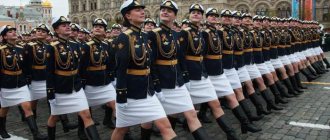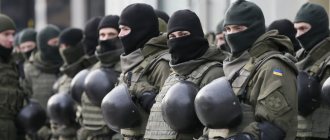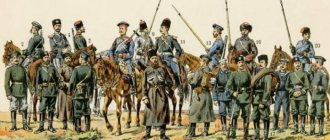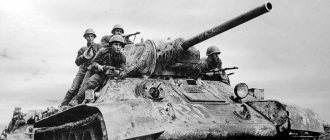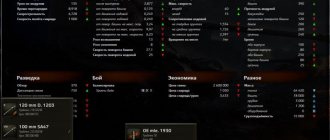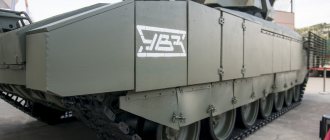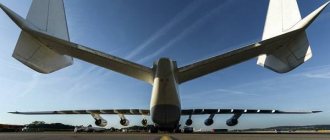Only a baby in our country doesn’t know what a T-34 is. However, few people can boast of having personally driven the legendary car. But the host of the “Chasovoy” program on Channel One, Alexey Rafaenko, succeeded. This is his story:
“The T-34 medium tank has been well known to us since childhood thanks to films about the Great Patriotic War. You could also see him during the Victory Parade on Red Square. Although, probably, I’m unlikely to reveal a secret to anyone if I say that cars that are taking part in the procession are not witnesses of the war, since they were made much later, after 1945. Of course, you can’t call them remakes, but you can’t call them veterans either. These are tanks of the T-34-85 modification (the number indicates the caliber of the gun - 85 mm) and they are slightly different from the T-34-76, which took part in battles until the first half of 1944. In general, the Thirty-Four is the most popular tank of the Great Patriotic War. Over the entire period, more than 54 thousand of these machines were produced.
I don't care about fat, I wish I was alive
A distinctive feature of the Sniper tank is its unusual turret - without a commander's cupola. Only a few of these have survived today. In addition, it does not have rubberized pads on the rollers. The thing is that at that time there was not enough rubber in the country and tanks had to be riveted in a minimal configuration - just to drive and shoot. For the same reason, during the war, the modification of the T-34 varied depending on the manufacturer. Relatively speaking, each enterprise made its own additions or changes to the basic design, depending on what parts were available. The absence of rubber braids makes the tank harsh and loud. I think the crew suffered a lot in it, since the car had little cushioning. However, it is unlikely that at that time anyone was concerned about the comfort of the tankers - they simply had to drive the enemy away from their borders.
As I said, the T-34 "Sniper" is in excellent condition. He is on the move and we were even allowed to see how confidently he drives. To be honest, they didn’t let me use the levers of this particular tank, despite my extensive experience driving armored vehicles. As they say, “grandfather” is already quite old and experts fear for his health if I suddenly do something wrong. It’s a miracle that this classic “Thirty-four” was restored and now it proudly drives under its own power, and is also demonstrated at various exhibitions and festivals.
In Soviet Russia, machines design you
“In Soviet Russia machines design you,” an American could joke and be very close to the true state of affairs. The situation with the creation of machines for people was indeed so terrible that some modern researchers even came up with a special term: “machine feudalism.” This means that the design approach was to take into account the characteristics of machines first, and people had to adapt to them.
This approach was a rudiment of the once popular ideas of Frederick Taylor, who believed that a person is “a cog or nut in a great machine.”
This callous attitude was criticized by Russian scientists Bekhterev and Myasishchev in the 20s. And Zamyatin in the novel “We” built a dystopian society on the principles of Taylorism. But who in the USSR was interested in the opinion of some humanists?
Of course, in the Soviet Union they knew about foreign research in the field of labor organization and ergonomics, conducted their own and even used some of it. But theory is one thing, and applying knowledge in practice is quite another, especially since additional factors intervened.
First, the weakness of some areas of Soviet industry. If some problem could not be solved in the design bureau and factories, then the Soviet military personnel had to overcome it.
Secondly, in the USSR the technical side has always dominated over the humanitarian side. While solving the problems of “how to cram everything into a tank with a very dense layout,” no less important questions related to people: their physiology or psychology could well have been lost.
Transporter TR-1 (TR-26) based on the T-26 tank. You won't believe it, but it was intended to transport 14 paratroopers
And finally, the most important factor. The country's political and party leadership often interfered in the development of weapons. It’s incredible, but if the army’s dual command ended in the fall of 1942, then the dual command in the defense industry successfully survived the war and died only with the USSR.
What did this mean? For example, in the fact that political and party leaders could “push through” the desired decision or even the type of military equipment. They could have forced the military or gunsmiths to take the wrong path, they could have ordered the production of “raw” equipment to begin - simply “so as not to offend the comrades from the fraternal republic.” Even the appointment of a chief designer or engineer at a defense plant could not be done without party bodies.
On the left is a floating airborne tank with variable ground clearance - “Object 911B”.
All this in total (plus the personal ambitions of managers and designers) periodically gave rise to inconvenient and even downright crazy decisions. For example, the passion for “missile tanks”, the “all in the turret” layout scheme (“Object 911B”), attempts to reduce the crew to two people or place the driver in the new T-64 tank, cutting him off from the rest of the crew with an ammunition rack.
Experiments with the “all in the turret” layout scheme failed due to the human factor: the driver simply lost the “feeling of the car” and direction.
The famous tank in action
We were able to test the T-34 ourselves in the Patriot Park in Alabino, Moscow Region. This was a later modification of the combat vehicle with an 85-mm cannon. Such tanks began to enter service with the Soviet army in the second half of 1944. Of course, I was very interested in seeing the car from the inside and finding out what it was like on the move.
The cabin is quite cramped, despite the fact that the T-34-85 could accommodate a crew of five, while the previous version had four tank crews. At that time, it was necessary to separate the functions of gunner and commander for greater efficiency - otherwise people could no longer cope. After that, the tank didn’t become any more spacious. For example, it was extremely inconvenient for me to make my way to the driver’s place. We must also take into account that when we climbed into it, there was no ammunition in the cabin. During wartime, several dozen shells were placed there. Getting through the hatch itself also turned out to be a difficult task. In the movies, tankers deftly jump in there and jump back out, but to do this in reality requires a certain dexterity.
Everything is in sight
The controls of the T-34-85 are basically the same as in modern tank models. The only thing is that everything is simpler and nothing is hidden anywhere. Almost all electrical and mechanical traction are in front of your eyes. Gearbox, transmission, clutches - everything is here. You can observe how it all works, what goes where and how it affects your car. Due to austerity, no one at that time thought about ergonomics or any kind of false panels. Again, from the point of view of maintainability, perhaps this approach is even more correct. Due to the fact that all mechanisms are open, the driver and other crew members could easily reach any component to repair it. Nowadays, we are used to almost going to a car service center, but back then we had to do most of the work ourselves, unless of course there was serious damage involved.
We drove around the training ground a little. The tank is really very playful. It is immediately clear why he was valued among the troops. The maximum speed on the highway is 54 km/h, and on rough terrain - 36 km/h. I note that even 30 km/h in the fields is already a very decent speed. That is, it cannot be said that these multi-ton armored vehicles lumbered awkwardly - on the contrary, it quickly picks up speed and quickly rushes forward. You can really feel the power in it.
I did not experience any problems with the movement of this tank. The only thing is that I myself treated it very carefully and reverently, I was very worried that I might damage something. Due to its age, the car is very capricious in relation to the clutch, the operation of the clutches, and so on. The fact that it can break is not so bad; it will still need to be repaired. We return again to the issue of finding spare parts. You can’t just go and get everything you need from the nearest warehouse. Therefore, the mechanics who drive these tanks treat the cars with great love - almost like their own. It even seemed to me that they treat their personal cars less carefully.
These troublesome leather bags
Scientifically speaking, military ergonomics includes everything that concerns the “man-machine-environment” system.
We humans are such delicate creatures - in order to act effectively, we need to eat, sleep, breathe; It is desirable that the environment is not too hot and not too cold, and the atmosphere is not toxic. Simply put, a person “works” with some kind of weapon while being in a certain environment and conditions. And this environment seriously affects a person’s effectiveness. For example, you are trying to win a duel with an enemy tank. At the same time, it’s night, winter, you ate the day before yesterday, but you don’t remember when you washed yourself...
One way or another, humanity has been dealing with issues of weapon ergonomics since ancient times, when such words were not known. The problem of adapting weapons and equipment to humans arose seriously during the First World War. The size of armies and losses grew, and weapons became more complex and significantly more expensive. In such conditions, one could not expect that all conscripts would be geniuses and master the difficult technology themselves.
Mark I cutaway
The Mark I tank required four people to operate. The driver switched gears and controlled the main clutch (in a language understandable to car enthusiasts, the clutch), the commander controlled the brakes, and two driver assistants switched the onboard gearboxes.
The simplest action - turning the tank - was the result of very well-coordinated teamwork.
But the tank doesn’t just drive like that. He must fight. And it’s one thing when an expensive combat vehicle is destroyed by the enemy in battle - it’s unpleasant, but that’s what it was created for... as long as it completes the task. And it’s completely different if this machine breaks down due to the “human factor” without even having fought.
The World War provided an excellent opportunity to conduct research, test some theories in practice, and most importantly, collect enormous amounts of statistical and scientific data that had never been collected before.
The gunner's workplace in the German A7V tank. Behind the engine, around 23 comrades, pigeons and mountains of supplies and equipment
The aviators approached the issue earlier and more thoroughly than anyone else: after all, the cost of a pilot’s error is much higher than that of the crew of an armored vehicle. New areas of knowledge have appeared in aviation: for example, aviation medicine and psychology, as well as new developments such as flight simulators.
After the war, the work continued, and the data was systematized. The Second World War further spurred scientists on, and in the period from 1940 to the mid-50s, military ergonomics finally emerged as an independent field of knowledge. Even the terms “ergonomics” and “human factor” themselves came into use during that period.
Loader in the Valentine tank
Research focused mainly on the aerospace industry, and some discoveries turned out to be so important that they were taken from pilots and began to be used in other branches of the military, including armored forces.
In the late 70s, after a series of plane crashes, the US National Transportation Safety Board proposed training aircraft crews using the CRM (Crew Resource Management) method, and in 1996, a similar methodology was proposed to be used to train crews of combat vehicles, including tanks.
Anton Zheleznyak Technical and engineering expert
The key feature of the methodology is the emphasis not on solving technical issues, but on practicing the interaction of crew members with each other, including in emergency situations.
Bed net as a means of protection
The T-34 was a very promising tank and in some places ahead of its time. At the same time, it is clear that its armor was much weaker than that of modern combat vehicles. Current tanks have not only passive (the armor itself), but also active protection, which is capable of defeating approaching threats even before they impact the vehicle. Of course, there was no talk of anything like that at that time, if only because there were no such grenade launchers. The infamous Faustpatron appeared towards the end of the war and became a serious disaster for our tank crews. The so-called “faustniks” could easily hide, and then suddenly crawl out of some gap and fire at the tank from a short distance. Although the vehicle itself could survive such a blow, its crew often died. I had to use my everyday wits. If you look at footage of military chronicles, you will see that tankers tried to build a prototype of modern dynamic protection - they sculpted some kind of bed nets, old bicycles onto the equipment... in a word, they tried to equip the tanks with additional iron so that shells would burn through this pseudo-protection on approach before getting to the armor itself. However, I was never able to find out whether this technique actually helped, or whether all this was done more to reassure the tankers.
Live target
I had the opportunity to interview a tanker, a mechanic-driver of the T-34 tank, who fought in this type of vehicle for a total of almost two years. Great Patriotic War veteran Boris Pirozhkov, who was only 18 years old at that time, speaks of the car with great love. Over the course of two years, this tanker changed three crews and five vehicles and was ultimately seriously wounded during the assault on Konigsberg and was discharged. According to the veteran, it is a great illusion to think that in a tank you are protected from everything. Just the opposite - on the field, everyone and everything shoots, first of all, at the tank. The same infantryman is still on his own. It is clear that he is more vulnerable, but it is easier for him to hide. But if you are sitting in a tank, then armor-piercing guns are firing at you, planes are dropping bombs on you. At the same time, it is also important to say that it was the driver mechanic in the tank who was considered the most “survivable”. Its location is still slightly lower than that of the rest of the crew, despite the fact that the main damage was inflicted, of course, in the area of the turret cut and on the sides of the tank - the armor there is thinner. So the driver mechanic still has a slightly better chance of survival. Plus, it has its own escape hatch in case the car is hit, it catches fire and stops moving.
The stability of the T-34 also left much to be desired. Looking at this huge multi-ton machine, it’s hard to imagine that it can literally be put on its hind legs. As Boris Pirozhkov said, the impact of a small aerial bomb is enough for the tank to stand at an angle of 90 degrees. But, nevertheless, I repeat: at that time it was one of the best armored vehicles - the Victory tank, which went through the war from the first to the last day.”
Interesting facts about the T-34:
- In the manufacture of the Thirty-Four, automatic submerged arc welding was used. Before this, no one in the world had used such technology in mass production. Thanks to it, the productivity of welding work has increased 10 times.
- The T-34 has a wide operating geography. This is the world's first medium tank, which was used from the Arctic to southern Africa, in all time zones.
- By 1944, the cost of the domestic T-34 tank was, according to rough estimates, 40 times lower than the cost of the German Tiger. Although the question of whether it is appropriate to compare a medium tank with an 85 mm gun and a heavy armored monster with an 88 mm gun still remains open.
- The T-34 is often called the weapon of the Great Victory, but this vehicle took part in many military conflicts after World War II. For example, the tank witnessed the Chinese Civil War (1946–1949), the Suez Crisis (1956–1957), the Vietnam War (1965–1975) and the Yemeni Civil War (2014). –2015).
- In Russia, the T-34 was officially withdrawn from service only in 1993. Until 2005, a large number of vehicles remained at weapons and equipment storage bases, then they were transferred to museums throughout the country.
Technical characteristics of the T-34-76 tank
| Weight 28.2–30.9 t |
Technical characteristics of the T-34-85 tank (replaced the T-34-76 in 1944)
| Weight 32 t |
Watch episodes of the “Courtry” program with Alexey Rafaenko at
official website of Channel One. And the issue about the T-34 is here.
How to rear a Soviet T-34 tank and other interesting facts about it
Service with comfort
The convenience of the crew's location in the tank directly affects its combat effectiveness. This is especially true for the physically busiest driver. The British "Chieftain" became the first serial main battle tank in which the ergonomics of the driver's workplace went beyond existing standards, making the tank a kind of "Mercedes" among the "Cossacks".
The essence of the problem
There is an opinion that tanks are not about comfort at all, and it is not needed there, the most basic amenities will suffice. Indeed, during the Second World War this is what they got by with. The designers believed that the average time of combat work for a crew in a tank per day was four to six hours, so a simple seat, a fan for removing powder gases and a work place in the volume of which you can move your arms at least a little is quite enough. After the war, standards began to change. More reliable cars have appeared that can withstand thousands of kilometers, and, most importantly, the threat of nuclear war looms over the world. Potential nuclear war and possible radioactive contamination put new demands on the tanks: the crew now had to be able to remain in a pressurized vehicle for up to 24–48 hours at a time. Consequently, comfort indicators in a modern tank should increase in proportion to the increasing load on the crew.
Let's look at three problems of ergonomics in the workplace of tank driver mechanics of the 1950s and 1960s and ways to solve them, presented in the British Chieftain tank.
Workplace of the driver of the "Chieftain" tank. Source: Scientific and technical collection “Issues of Defense Technology”, series VI , issue No. 6 (112), 1983
The first problem that interfered with the effective work of the driver was the large number of physically difficult routine operations. On average, the driver performs 164 operations, which include driving control (shifting gears, controlling the turn levers, etc.) and controlling the auxiliary systems of the power plant. A tank gunner, whose work does not require increased energy consumption, performs an average of 128 operations. The commander is responsible for 199 operations, and almost half of them relate to terrain surveillance, target designation and interaction with other units.
The next problem is the location of the driver at his workplace. Before the advent of the Chieftain, the generally accepted standard in Western tank building—in Soviet/Russian tank building the standard is still relevant—was an upright sitting position for the driver. On the one hand, this significantly simplified or at least did not complicate the overall design and production technology of tanks. On the other hand, an upright sitting position leads to fatigue. In this position, the human skeletal muscles are in constant struggle with gravity. As a result, the appearance of pain in the neck, lumbar region and knee joints, numbness of the limbs and the appearance of tremors. As a result, the driver begins to concentrate on his own unpleasant sensations and is distracted from driving. Concentration decreases, decision-making time increases, and mood worsens.
A less important, but somehow completely forgotten factor that affects the combat work of the driver is the location of instruments that inform about the most important parameters of the power plant. Research shows: the more inconveniently located the main driver's panel, the less the driver monitors it and the more often breakdowns and forced stops occur due to oversight during marches and direct combat operations. As a rule, tank driver mechanics, whose workplaces have incorrect instrument layout, on average react to an unacceptable deviation in the parameters of the power plant only after 45–60 seconds, especially when driving “on the move.” Typical errors in the layout of the driver's dashboard are its placement away from the driver's main line of sight with the indicator windows located perpendicular to its axis, as well as the lack of a clear grouping of instruments according to the importance of indicators and purpose.
The above can be summarized in literally three lines. Tests of the Soviet T-55 and T-62 tanks, which combine all of the above problems, showed that due to fatigue and lack of an acceptable level of comfort among tank crews, the average speed at the end of daily training marches dropped by 15–20%, and the number of errors by training routes increased sixfold.
Automation of movement control of the Chieftain tank
In the work of a tank driver, the motor component is most pronounced. The driver performs a large number of energy-consuming actions, which are based on moving the fuel pedal, moving the steering levers and changing gears. For example, in a fully “mechanical” T-62 tank, in one hour of driving, the driver presses and releases the gas pedal an average of 1291 times, uses the steering levers about 809 times and changes gear about 17 times. In numerical terms, the energy consumption for these actions is at the level of 1.34 kW. Based on this, one of the important ways to solve the problem of driver workload is to install an automatic or semi-automatic gearbox. Research shows that the implementation of such systems on average reduces the driver’s workload by half, reduces the requirements for his qualifications and training duration, and also eliminates driving errors that lead to the tank’s engine stopping.
The engine and transmission compartment of the Chieftain. The tank's mechanical transmission with elements of an electro-hydraulic gear shift system is visible. Source: Chieftain Tank Appreciation Society Facebook group
The British tank "Chieftain" uses an original semi-automatic electro-hydraulic gear shift system for a mechanical planetary transmission, in which the main control is a double-action pedal located under the driver's left foot. Shifting gears from lower to higher, from first to sixth, is done by pressing the toe of the pedal on the pedal in a sequential movement from bottom to top. Accordingly, switching from higher to lower, including two reverse gears, occurs by pressing the pedal down. Nothing more is required from the driver - no “repeats” and no clutch/drain pedals. The system automatically, in accordance with engine speed, engages the selected gear and signals this on a dial gauge, which shows the number of the engaged gear.
To the driver's seat from the fighting compartment. The gear shift pedal is visible in the center in front of the seat. Source: Chieftain Tank Appreciation Society Facebook group
The semi-automatic system is based on a counting and solving electromechanical device (controller) and an executive unit consisting of six electromagnets with hydraulic spools. When the desired electromagnet is turned on, the spool moves and oil is supplied to the hydraulic booster to activate the corresponding brake in the gearbox. The electromagnet is turned on after a signal from the centrifugal speed converter of the engine shaft, the pressure switch in the brake system, the reverse button and the parking brake. A centrifugal converter connected to the input shaft of the gearbox generates signals that permit upshifting or downshifting, and also transmits a signal for automatic downshifting.
The Chieftain's semi-automatic system has several degrees of protection. If the tank for some reason loses speed - for example, on a difficult terrain or due to a driver error - the semi-automatic system independently lowers the gear down to neutral, excluding stopping the engine. Roughly speaking, the driver does not need to downshift at all - this is done for him. Emergency situations are also common - for example, loss of oil pressure in hydraulics. Since the driver does not always have time to pay attention to this, when critical parameters are reached, the system automatically reduces the speed of the tank and successively downshifts until the vehicle comes to a complete stop. Due to the fact that gear shifting is carried out by a pedal, the driver, while driving the tank, may accidentally engage reverse gear. To protect against such situations, turning on reverse is possible only after stopping and pressing the corresponding button on the driver's panel.
Electrical gear shift control system diagram.
Source: Scientific and technical collection “Issues of defense technology”, series VI , issue No. 6 (112), 1983
Tests of the Chieftain in the USSR showed that the semi-automatic gear shift system used in its design deserves attention, since such a design solution, in comparison with domestic cars, significantly reduced the load on the driver and did not cause any problems in adaptation. In addition to comfort, semi-automatic, relieving some of the responsibilities from the driver, improves purely technical parameters compared to mechanics - in particular, it increases average speeds. Run tests of the Chieftain Mk.5R in the USSR showed that a vehicle weighing 55 tons with a 750 horsepower engine when driving over very rough terrain has an average speed of 22.1 km/h, which is only 2.4 km/h less than the much lighter T-62.
Seat and dimensions of the driver's workplace
The famous semi-lying position of the driver in the Chieftain was used in order to reduce the height of the tank hull and give its frontal part a more advantageous shape in terms of projectile resistance. Thanks to this innovation, the engineers managed to kill two birds with one stone: they solved the problem with the height of the hull, and significantly increased driver comfort.
Semi-recumbent position of the driver of the Chieftain tank. Simulator for driver mechanics. Source: Chieftain Tank Appreciation Society Facebook group
As already noted, a vertical sitting position negatively affects the combat performance of the tank driver. It's not just about fatigue, muscle tension and pain from such a position - such a banal component as the low height of the control compartment is also important.
It is believed that an important parameter by which one can judge whether a person is fit to become a tank driver is his height. This is especially true for driver mechanics. However, there is a small problem here. A driver cannot be very tall - it’s an obvious fact. A person whose height is below 165 cm cannot become one. There is a completely understandable explanation for this: a tall person simply will not fit in the control compartment, and it will be extremely inconvenient for a short person to use surveillance devices. However, even those candidates whose height is in the region of plus or minus 170 cm are often not suitable for service in this position.
The average height of driver's workplaces equipped with a vertical seat, from the seat to the roof, is 830–850 mm. Therefore, for a comfortable position, the height of a person in a sitting position should not exceed these values. However, on average it still exceeds them. Studies conducted among military personnel during selection for tank crews showed that the average height in a sitting position is 880–885 mm. In practice, this means that a significant number of driver mechanics who have passed a medical commission and are allowed to perform their duties, in addition to all the inconveniences in the tank, are also forced to be in a half-bent position. Increasing the height of the control compartment, as well as the overall height of the tank, is often impossible, and therefore the introduction of a semi-reclining position for the driver seems preferable.
The Chieftain tank uses an original solution in the form of a seat, which is adjustable in several positions. To position the driver in a “traveling” position with his head hanging out of the hatch, the seat back takes a vertical position. When the hatch is closed, in the combat position, the seat back, depending on the physical characteristics of the driver, reclines 45°, 50° or 55° from the vertical and thereby ensures the physiologically most correct position of the rider. Depending on the position of the backrest, the position of the tank movement control levers is automatically adjusted. To allow the driver to rest or to move to the fighting compartment, the backrest can recline 90°, turning the seat into something like a short couch.
Metal frame of the driver's seat of the Chieftain tank. Source: Chieftain Tank Appreciation Society Facebook group
The dimensions of the Chieftain’s driver’s seat do not particularly stand out among Western “classmates” and can provide the proper level of comfort for people with different body constitutions. The seat width is 430 mm, depth - 410 mm, cushion thickness - 45 mm. Back height - 430 mm, width - 500 mm, thickness - 45 mm. For example, in the Soviet T-62 tank the seat width is 355 mm, depth - 360 mm, thickness - 50 mm. Back height - 375 mm, width - 320 mm, thickness - 50 mm.
Despite the fact that when developing the Chieftain, the designers paid special attention to reducing the height of the hull, the driver’s workplace is far from cramped. Its structural height is 880 mm, so you can sit there as well. The length of the workplace is 1920 mm, width is 530 mm. The seat can be moved forward or backward by 150 mm in increments of 25 mm. The height of the seat is not adjustable, since the driver's viewing device has a wide exit window, it is convenient to use it at a distance from the eyes of up to 300 mm.
Reviews from driver mechanics who had previously had extensive experience driving tanks with a classic workplace layout stated that when working in the Chieftain, fatigue, muscle stiffness, and pain in the neck and knees are significantly less evident. Due to the large supporting surface of the seat and its anatomically correct location, the impact of shock loads on the spine has decreased. The problem of drivers' height not meeting standards in a sitting position has been completely resolved.
Driver's dashboard
In accordance with generally accepted standards, the information provided to the driver must reflect the most significant indicators and be unambiguous, without requiring decoding and increasing the time for decision-making. To prevent the driver from “running his eyes” during combat work, looking for the desired indicator, all instruments displaying critical parameters of the power plant, a significant change in which can lead to breakdown or stop, must be located in the central viewing area at an angle of about 15° horizontally and vertical relative to the line of sight. The remaining indicators can be moved to the side on a separate panel.
The main dashboard of the Chieftain driver is located in the optimal zone - centered in front of the eyes. It contains instruments that display the necessary parameters of the power plant: engine speed, coolant condition, gear number, speed and fuel level. Less important indicators and switches are located away from the driver. Thanks to this arrangement, the negative parallax effect is minimized when viewing the main instrument panel. As a result, the driver spends less time focusing on the instruments and reading information from them.
Driver's main dashboard. Source: Chieftain Tank Appreciation Society Facebook group
Since the driver-mechanic in a combat situation does not always have time to monitor the indicators, an alarm is provided: when a critical level is reached, an audible emergency signal is given, which can be heard both in the headset and without it. To make it easier to read, the main instrument panel uses color coding of information in the form of multi-colored lamps above the dial instruments. In order for the driver to react faster, not only sound is used as an indicator of emergency and critical information, but also an integral indicator in the form of a red lamp.
One of the advantages of the main instrument panel is its location under the upper frontal part of the body at a distance from the driver's hatch. When driving “travelling”, this prevents the indicators from being illuminated by direct sunlight penetrating through the hatch. Together with the bright illumination of the instruments, this ensures acceptable light contrast and sufficient visibility of the needles and scales.
In general, the layout of the dashboard and the block type of indicator distribution in the Chieftain have a number of advantages. The indicators are divided into functional groups corresponding to the importance of the indicators. The main dashboard is not overloaded with auxiliary elements. All instruments are placed taking into account the driver’s sensory field, and their number and nomenclature are reduced to a minimum, which makes it easier to read information and less distracting from observing the terrain and driving.
Conclusion
At the time of its appearance, the Chieftain was the world’s first mass-produced main tank, in which the convenience of the driver’s workplace was taken to a whole new level. Before this, Western tank builders had not dared to take such a bold step. Of course, later Western tanks acquired automatic transmissions, steering wheels and computerized motion control systems, but the Chieftain is rightfully considered a pioneer in this matter. The successful layout of this vehicle proved its effectiveness in battles and service in peacetime, determined the concept of British tank building for forty years to come and was embodied in the future Challenger 1 and Challenger 2 tanks.
Yuri Pasholok
/
"Panther" in English
The history of the creation of the British cruiser tank A41 Centurion
- tanks
- Great Britain
Yuri Pasholok
/
Experiment at an infantry base
History of the creation and use of the British Bishop self-propelled artillery mount
- WWII
- tanks
- artillery
- Great Britain
Yuri Pasholok
/
In the role of always lagging behind
British armored forces in the interwar period and at the beginning of the Second World War
- WWII
- tanks
- Great Britain
- interbellum
Literature:
- Belyaev, S.V. Means for displaying information about the operational parameters of the tank / S.V. Belyaev // Questions of defense technology: Scientific and technical collection. - 1982. - pp. 18–19.
- Rubashkin, D.S. Features of the construction of crew workplaces / D.S. Rubashkin, V.V. Troitsky // Questions of defense technology: Scientific and technical collection. - 1983. - pp. 9–12.
- Zaslavsky, E.I. Features of the tank control department / E.I. Zaslavsky, A.A. Reshetov // Questions of defense technology: Scientific and technical collection. —1983. — P. 3–5.
- Rozhko, V.A. Results of run tests of the tank / V.A. Rozhko, A.M. Rozhkov, F.P. Shpak, V.I. Shchetinin // Questions of defense technology: Scientific and technical collection. - 1983. - P. 5–10.
- Dombrovsky, Yu.K. Transmission and motion control system / Yu.K. Dombrovsky, E.I. Karnachev // Questions of defense technology: Scientific and technical collection. - 1983. - pp. 28–30.
- Karnachev, E.I. Semi-automatic gear shift control system / E.I. Karnachev, V.F. Lobasenko // Questions of defense technology: Scientific and technical collection. - 1983. - pp. 31–34.
- Habitability of armored vehicles / V.D. Lubensky, V.D. Rebrikov, N.V. Egorova [etc.]. - 1974. - 151 p.
- Theory and design of the tank: Ergonomic support for tank development. - M.: MECHANICAL ENGINEERING, 1986. - 191 p.


